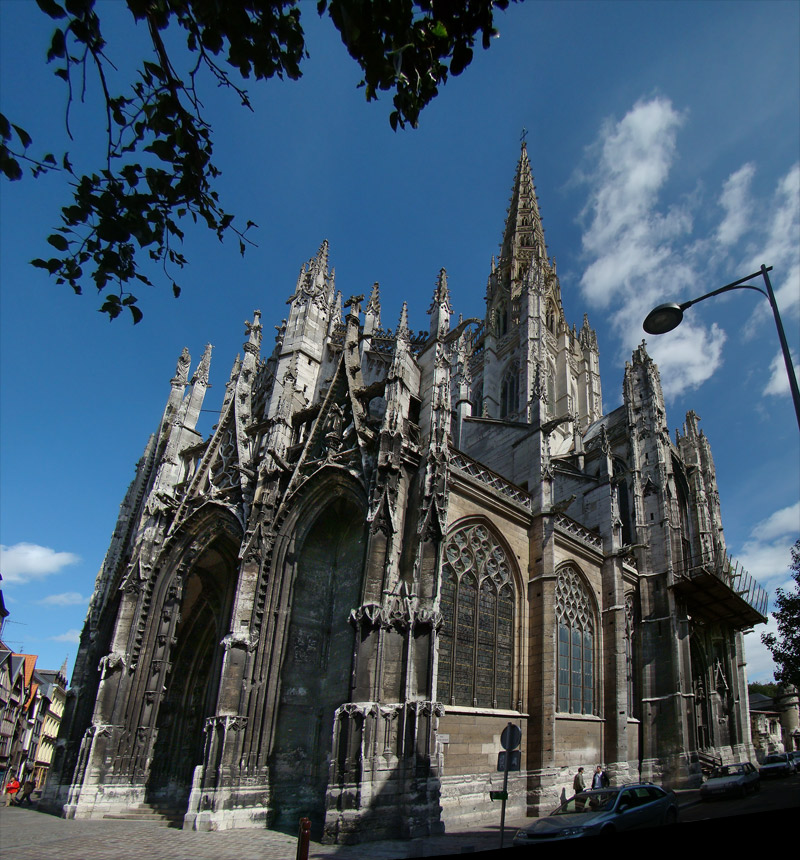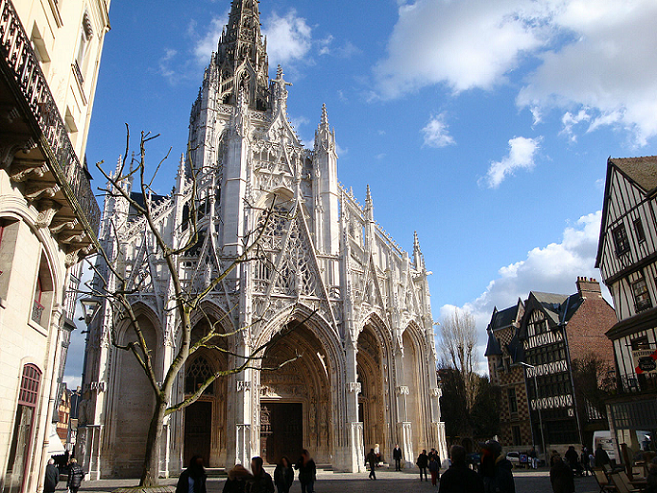The Gothic was a growing contrast to the Romanesque. There are three main stages of the Gothic: early, high, and late. Studying the growth through this movement is essential to understanding its purpose. First one needs to learn about the Romanesque, to understand the movement that preceded it.
The Church of Saint-Pierre (shown above) is the best example of Romanesque sculpture that is preserved today. Above is the facade of the church.
The sculptural elements here are unmistakably Romanesque. Romanesque sculpture, like other movements, was very involved in architecture. The sculpture of this time is recognizable by a few elements. The sculpture became more and more separated from the wall and articulated. Also to the left and right of the main column in the middle, there are small embedded columns into the sculpture. One can see these clustered columns throughout Romanesque architecture.
The Early Gothic 1140-1194
The early Gothic is only the beginning of the departure from the Romanesque. One can notice small changes in these structures and their decorative elements such as the sculpture.
The Church of Saint- Denis shows the first early remnants of Gothic Architecture. These components will become much more pronounced as the Gothic grows. Abbot Suger was a monk in this church in 1122 and became abbot to the church. Suger quickly noticed that Saint- Denis church was falling into dis-repair and it was much too small to accommodate the tombs and the growing number of pilgrims coming to the church. So Suger set out to campaign to rebuild this church. One of the main components changed was adding sculpture to the entrances. Another was adding radiating side chapels to the church where visitors would visit each one independently. There were dividing walls, unlike the Romanesque. Lastly, stained glass windows and oculus windows were added.
Interior shot- showing isolated chapels
In this plan, one can clearly see the radiating chapels.
High Gothic 1194-1300
As the Gothic continues to progress, architecture becomes more and more decorative. The sculpture becomes more pronounced, and the layout of churches continue to change.
** Note: this picture was taken before the 2019 fire **
The infamous Notre-Dame Cathedral is one of the best examples for the high Gothic. Many elements including flying buttresses, isolated sculpture, pointed archways, and more contributed to the trailblazing of the high Gothic. The pointed archways can be see on the inside of the cathedral as well as outside. Also Notre-Dame has small stained glass oculus windows in each bay.
Above is a diagram from a textbook. Use this diagram to understand the terminology used and where the components are located.
Above is the main entrance on the facade. Notice that the archways are pointed, and the sculpture is less and less relief.
This is the main facade of Notre Dame. This image was taken before the 2019 fire.
Late Gothic 1300-1500
During the late Gothic, sculptural embellishment took over the structure of churches. Also the intricate and delicate decoration became more and more exaggerated.
Not only did the Late Gothic still oppose Romanesque norms but Late Gothic shows even a small departure from the High Gothic. The Late Gothic is even more flamboyant that the late Gothic. Looking closely at the sculptural decoration of Église catholique Saint-Maclou (above), one can see the five sharply crafted entries into the church. Comparatively, this church is much small that the others earlier in the Gothic.
After the Gothic, the Renaissance movement started to form and strove to return order to art and architecture. Read
THIS post to learn about the Renaissance.
Sources Cited:
"Art 205 Exam 1." Chegg, www.chegg.com/flashcards/art-205-exam-1-e15349f2-3fd5-4cbe-8cc9-ea18bdfe242b/deck.
By Bordeled - Own work, CC BY-SA 3.0, https://commons.wikimedia.org/w/index.php?curid=21209769
By Diliff - Own work, CC BY-SA 3.0, https://commons.wikimedia.org/w/index.php?curid=40697203
By Membeth at German Wikipedia - Own photograph of de:User:Membeth, originally from de.wikipedia; description page is/was here., Public Domain, https://commons.wikimedia.org/w/index.php?curid=2303585
By Nortmannus - Own work, CC BY-SA 3.0, https://commons.wikimedia.org/w/index.php?curid=31476744
By Peter Haas, CC BY-SA 3.0, https://commons.wikimedia.org/w/index.php?curid=32131500
By sacratomato_hr - DSC_0732, CC BY-SA 2.0, https://commons.wikimedia.org/w/index.php?curid=33334184
By Tango7174 - Own work, CC BY-SA 4.0, https://commons.wikimedia.org/w/index.php?curid=6433217
By Thomas Clouet - Own work, CC BY-SA 4.0, https://commons.wikimedia.org/w/index.php?curid=42109690
Chapuis, Julien. "Gothic Art." In Heilbrunn Timeline of Art History. New York: The Metropolitan Museum of Art, 2000–. http://www.metmuseum.org/toah/hd/mgot/hd_mgot.htm (October 2002)
Gardner, Helen, and Fred S. Kleiner. Gardner's Art through the Ages: A Global History. Fifteenth edition, Student edition. ed., Boston [Massachussets], Cengage Learning, 2015.
Saint Maclou rouen france. Zephyrinus., zephyrinus-zephyrinus.blogspot.com/2016/11/the-church-of-saint-maclou-rouen-france.html. Accessed 22 Oct. 2020.
Do you like Art Movement Posts? Leave me a comment!
















No comments
Post a Comment